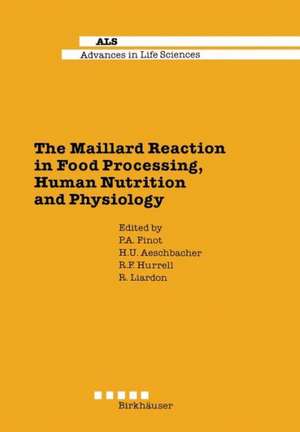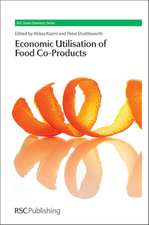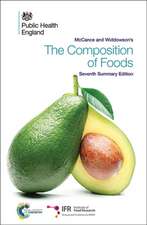The Maillard Reaction in Food Processing, Human Nutrition and Physiology: 4th International Symposium on the Maillard Reaction: Advances in Life Sciences
Autor P. Finoten Limba Engleză Paperback – 9 noi 2011
Din seria Advances in Life Sciences
- 15%
 Preț: 646.11 lei
Preț: 646.11 lei - 15%
 Preț: 645.96 lei
Preț: 645.96 lei - 15%
 Preț: 650.86 lei
Preț: 650.86 lei - 5%
 Preț: 365.99 lei
Preț: 365.99 lei -
 Preț: 417.02 lei
Preț: 417.02 lei -
 Preț: 394.51 lei
Preț: 394.51 lei -
 Preț: 387.20 lei
Preț: 387.20 lei -
 Preț: 391.02 lei
Preț: 391.02 lei -
 Preț: 389.70 lei
Preț: 389.70 lei -
 Preț: 400.26 lei
Preț: 400.26 lei -
 Preț: 399.88 lei
Preț: 399.88 lei -
 Preț: 396.62 lei
Preț: 396.62 lei -
 Preț: 398.15 lei
Preț: 398.15 lei -
 Preț: 409.69 lei
Preț: 409.69 lei -
 Preț: 395.47 lei
Preț: 395.47 lei -
 Preț: 390.25 lei
Preț: 390.25 lei -
 Preț: 382.95 lei
Preț: 382.95 lei -
 Preț: 387.38 lei
Preț: 387.38 lei - 15%
 Preț: 647.59 lei
Preț: 647.59 lei
Preț: 405.87 lei
Nou
Puncte Express: 609
Preț estimativ în valută:
77.69€ • 84.41$ • 65.30£
77.69€ • 84.41$ • 65.30£
Carte tipărită la comandă
Livrare economică 21 aprilie-05 mai
Preluare comenzi: 021 569.72.76
Specificații
ISBN-13: 9783034899192
ISBN-10: 303489919X
Pagini: 528
Ilustrații: VI, 516 p.
Dimensiuni: 170 x 244 x 28 mm
Greutate: 0.84 kg
Ediția:Softcover reprint of the original 1st ed. 1990
Editura: Birkhäuser Basel
Colecția Birkhäuser
Seria Advances in Life Sciences
Locul publicării:Basel, Switzerland
ISBN-10: 303489919X
Pagini: 528
Ilustrații: VI, 516 p.
Dimensiuni: 170 x 244 x 28 mm
Greutate: 0.84 kg
Ediția:Softcover reprint of the original 1st ed. 1990
Editura: Birkhäuser Basel
Colecția Birkhäuser
Seria Advances in Life Sciences
Locul publicării:Basel, Switzerland
Public țintă
ResearchCuprins
Preface.- The Maillard reaction by Ted Labuza.- Chemistry.- Chemical Pathways of the Maillard Reaction.- Roast Aroma Formation. The Role of Amino Acids During the Maillard Reaction.- Detection of Maillard Reaction Intermediates by High Pressure Liquid Chromatography (HPLC) and Gas Chromatography.- Oxidative Degradation of Protein-Bound Amadori Products : Formation of Nc-Carboxymethyllysine and N-Carboxymethyl Amino Acids as Indicators of the Extent of Non-Enzymatic Glysosylation.- Glucose-Lysozyme Reactions in a Restricted Water Environment.- Model Experiments on the Formation of N-?-Carboxymethyllysine (CML) in Foods.- Maillard Reaction in Sugar-Protein Systems.- The Role of 3-Deoxyglucosone in the Maillard Reaction.- Characterization of the Major Browning Derivates of Lysine with 2-Amino-2-Deoxy-D-Glucose.- Intramolecular Nucleophilic Substitution Reactions of Tryptophan and Lysine Amadori Rearrangement Products.- Related Ring Enlargement Reactions of Proline, Azetidinic Acid, Arginine and Lysine with Reducing Sugars.- Effect of Lipid in the Maillard Reaction.- Heterocycle Formation from Malondialdehyde and Amino Sugars.- Key Mechanistic Problems Posed by the Maillard Reaction.- Food Science.- The Influence of Maillard Reactions on the Sensory Properties of Foods.- Development of the Maillard Reaction During Food Processing.- Studies on Bakers Yeast as a Source of Maillard-Type Bread Flavor Compounds.- Flavor Problems Associated with the Microwave Cooking of Food Products.- Volatile Components of Okra (Hibiscus Esculentus L.) Formed as a Result of the Maillard Reaction.- The Mode of Action of Antibacterial Maillard Reaction Products.- Inhibitory Effects of Tea Extracts on the Formation of Advanced Glycosylation Products.- The Antibacterial Effect of Maillard ReactionProducts and Sorbic Acid at Different pH Levels and Temperatures..- Safety of Amino Acids Heated with Sodium Ascorbate.- The Chemistry of Coloured Compounds Formed During Sugar Manufacture.- Nutrition.- Influence of the Maillard Reaction on the Nutritional Value of Foods.- Metabolism and Physiological Effects of Maillard Reaction Products (MRP).- Balance Studies with Glycosylated Proteins on Human Volunteers.- Separation and Characterization of Metal Chelating Compounds in Coffee.- Antioxidative Effect of Maillard Reaction Products in Vivo.- Effect of Melanoidin on Cholesterol in Plasma, Liver and Feces in Rats Fed a High-Cholesterol Diet.- Immunodominancy and Antigenic Structure of Lactose-Protein Maillard Adduct.- Antibody-Binding to a Maillard-Reacted Protein.- Physiological Activity and Metabolism of 3-Deoxyglucosone.- Allergenicity of Malondialdehyde-Protein Complex in Soybean-sensitive Individuals.- Toxicology.- Mutagens and Carcinogens Formed by Cooking Meat and Fish : Heterocyclic Amines.- Anticarcinogenic Effect of Browning Reaction Products.- Maillard Reactions and the Formation of Genotoxic Amino-imidazoazaarenes (AIA) Present in Fried Meat and Fish.- Micromethod for the Determination of Heterocyclic Amines.- Scavenging of Active Oxygens by Melanoidin.- Inhibition of in Vivo Mutagenicity by Maillard Reaction Products and Coffee.- Mutagen Formation in Wheat Gluten, Carbohydrates, and Amino Acid and Gluten Carbohydrate Blends.- 2-0xoaldehyde-Metabolizing Enzymes in Animal and Plant Tissues.- Inhibition of Formation of Mutagens/Carcinogens During Cooking of Meat.- In Vivo Reaction.- The Maillard Reaction as a Basis for a Theory of Aging.- Nonenzymatic Reaction of Reducing Sugars with DNA.- Accumulation of Maillard Reaction Products in Tissue Proteins.- In Vitroand In Vivo Glycation of Human IgG.- Formation of Early and Advanced Glycation Products of Lens Crystal1ins with Erythrose, Ribose and Glucose.- Increased Glycation of Human Erythrocyte Cu, Zn-Superoxide Dismutase in Diabetic Patients with Cataracts and Retinopathy.- Autoxidation and DNA Cleavage Reaction of Glycated Proteins.- Biological Recognition of Advanced End Product of the Maillard Reaction.- Prevention of the Maillard Reaction and Reversible Destruction of Advanced Glycation End Products (Age) by Novel Organic Germanium Compounds and Aminoguanidine.- Parent Ion Spectroscopy Use in the Identification of Advanced Glycation Products.- Autoxidation of Amadori Compounds in the Presence of Copper Ion and its Effects on the Oxidative Damage to Protein.- Acceleration of Fructose-Mediated Collagen Glycation.- Decreased Actin Activated Myosin ATPase Activity by Non-Enzymatic Glycation.- Generation of Superoxide During and Autoxidation of Glycated Protein : Participation in Phospholipids Peroxidation.- Secondary Glycation of Nonenzymatically Glycated Protein by Fructose : a Possible Source of Fluorescence Generation.- Involvement of Monosaccharide Autoxidation in DNA Glycation under Physiological Conditions.








